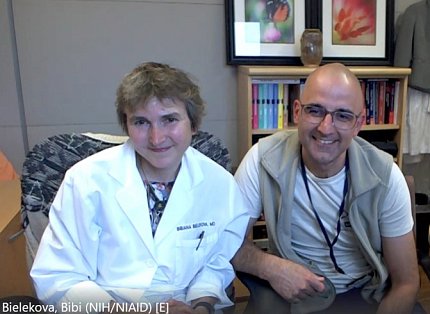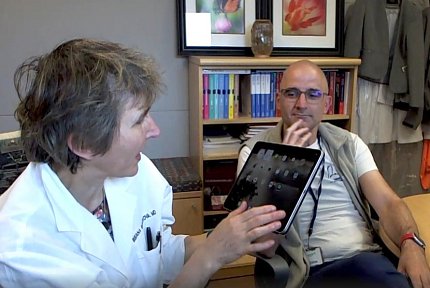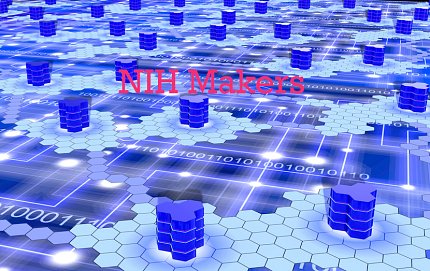Digital Timesaver Devised
Necessity Breeds Tool for Neurologists
This story is part of an ongoing NIH Record series on NIH makers and inventors.
There’s got to be a better way. That’s what drove Dr. Bibi Bielekova and Dr. Peter Kosa to conjure up a computer program that neurologists can use to visualize, digitize and record patient exam data quickly and readily.

“We have developed an application that allows digital documentation of neurological exams at bedside using an iPad [or other tablet device] and simple, intuitive layouts,” Kosa explained. “Development of the NeurEx platform was prompted by [two things]: our need to simplify a very cumbersome and user-unfriendly documentation of the neuro exam that had been available at the time and the need to collect raw, granular data from the exam in an electronic form that can be later used to various downstream analyses.”
Bielekova, chief of the neuroimmunological diseases section in the Laboratory of Clinical Immunology and Microbiology at the National Institute of Allergy and Infectious Diseases (NIAID) and staff scientist Kosa study neurological disease, with emphasis on multiple sclerosis (MS), a chronic, progressive disease of the central nervous system.
In their research, performing a thorough neurological exam is essential to determine the level of disability patients experience and the rate the disorder progresses over time. The data generated from the doctor’s clinical visit informs every subsequent decision about treatment and other aspects of patient care and research progress.
Back in 2018, Bielekova spent half a year transcribing 770 historical, paper patient records into digital format, so she could compare physician analysis to computer analysis. It had taken the two scientists about 18 months to fine-tune the first generation of their NeurExTM app.
“That tells you how painful the process was before, that she was willing to do this,” Kosa joked.
By 2019, the Clinical Center’s medical records department had replaced its old Clinical Research Information System (CRIS) form for documenting neuro exams with a web page that allows direct upload of a PDF file generated by the NeurExTM app into CRIS as an officially documented neuro exam.

“[My patient visit] is automatically streamed to the NIAID server,” Bielekova explained, “so by the time I walk from the clinic to the office, the exam is already documented…then we just negotiate [the medical record] field on the app’s touchscreen and voila! it’s uploaded into the patient’s medical record.”
Before they created NeurExTM, Bielekova and other physicians on similar clinical rounds used analog—pen and paper—to manually update patient records. Doctors spent hours on the task—writing in descriptions of each patient’s individual muscle damage or deficit—and they didn’t have the cool anatomical images and diagrams the app incorporates. One single exam could generate 12 to 14 pages of notes, which were not portable the way NeurExTM files are.
Other app design elements thrill users too.

Photo: Bee Bright/Shutterstock
For example, Kosa said, “NeurEx has embedded algorithms that automatically calculate various clinical scales of disability using the raw documented neuro exam data, including the FDA-approved gold standard of disability outcome in MS–Expanded Disability Status Scale. This feature dramatically reduces the amount of inter- and intra-rater noise and helps facilitate multicentric studies. We have already tested this feature during a multicentric project of Spinal Fluid Consortium for MS, funded by the National MS Society, where all centers used the NeurExTM app to document patients’ neuro exams.
Articles about NeurExTM development and performance were published in 2018 in Annals of Clinical and Translational Neurology. The app also has been presented at various international meetings and requested by several groups from inside and outside the United States. NIAID’s Technology Transfer and Intellectual Property Office filed an application with the U.S. Patent and Trademark Office in 2021.
Bielekova and Kosa continue to tweak their invention, periodically adding details and adjusting features.
“I just wanted to build something that empowers neurologists to better monitor patients’ disease and give them more and better information to help them make decisions about treatment options,” Bielekova concluded.
